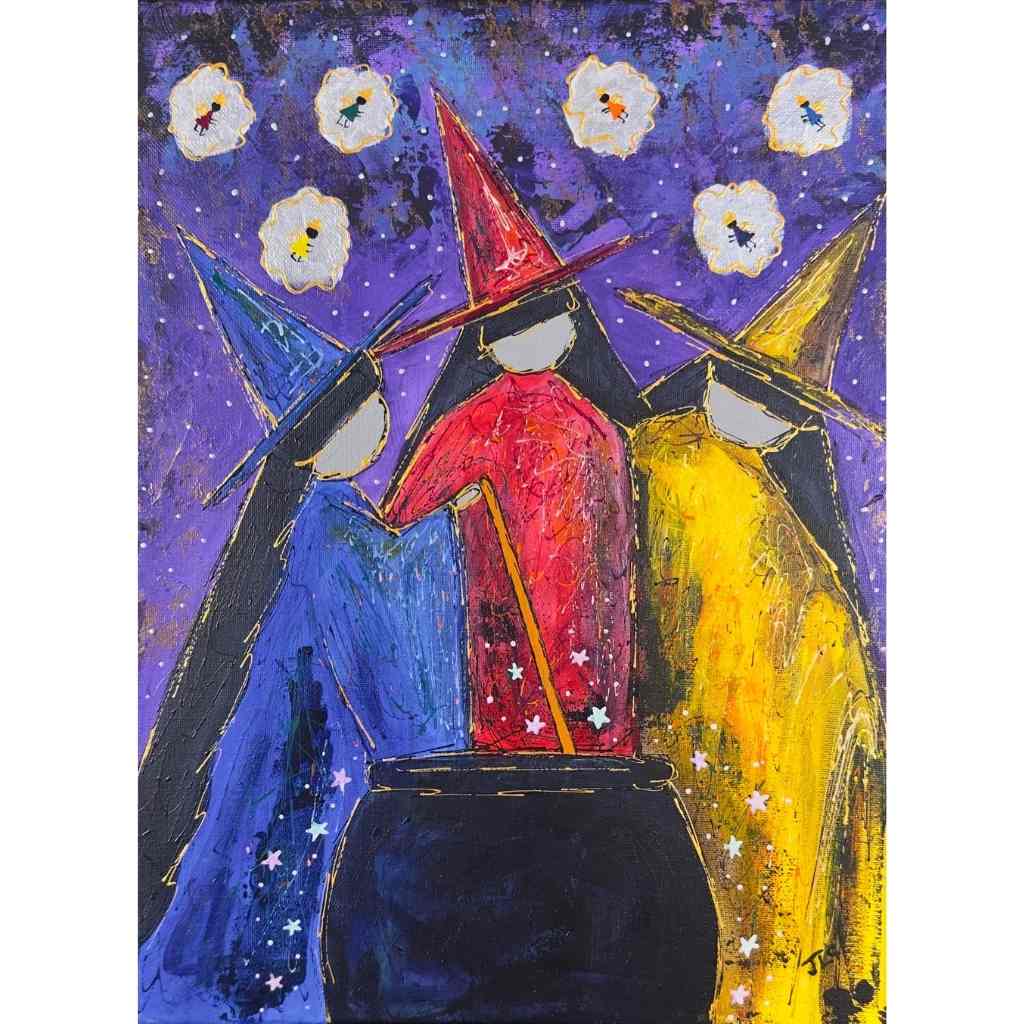Canvas Prints vs Original Paintings: Choosing Art for Your Space
Choosing between canvas prints and original paintings represents one of the most important decisions in building an art collection that truly resonates with your space and spirit. Each option offers distinct advantages depending on your budget, collecting goals, and the energy you want to create in your home. Understanding these differences helps you make informed decisions that bring lasting satisfaction to your art collecting journey. Explore our complete art collections to discover both original paintings and high-quality canvas prints across all our mystical themes.
Table of Contents
- Understanding Original Paintings
- The Appeal of Canvas Prints
- Quality Differences You Can See and Feel
- Investment Value and Collectibility
- Size and Placement Considerations
- Budget Planning for Art Purchases
- Care and Longevity Factors
- Making the Right Choice for Your Space
Understanding Original Paintings

Original paintings represent the artist's direct creative expression, where every brushstroke, color decision, and textural element flows directly from the creator's hand onto the canvas. These one-of-a-kind pieces carry the artist's energy in ways that reproductions simply cannot replicate, creating a unique presence that many collectors find irreplaceable.
The creation process of original paintings involves multiple layers of artistic decision-making that occur in real-time. An artist might start with an initial concept but allow the painting to evolve organically as colors interact, textures develop, and unexpected elements emerge. This spontaneous creativity becomes embedded in the finished work, creating depth and complexity that reveals new details over time.
Texture plays a crucial role in original paintings, particularly in works created with acrylic paint and palette knife techniques. These dimensional elements catch and reflect light differently throughout the day, creating a living quality where the artwork appears to change with lighting conditions. This dynamic interaction between the painting and its environment adds a temporal dimension that canvas prints cannot provide.
The energy signature of original paintings often feels palpable to sensitive viewers. Many collectors report feeling drawn to specific original pieces in ways they cannot fully explain rationally. This connection might stem from the painting's unique energetic imprint—the combination of the artist's intention, emotional state, and creative process crystallized in physical form.
Original paintings also represent complete artistic statements where every element serves the overall vision. Artists working on originals can adjust, layer, and refine elements until the piece achieves perfect harmony, often making micro-decisions that significantly impact the finished work's energy and appeal.
The Appeal of Canvas Prints

Canvas prints offer accessibility to beautiful artwork that might otherwise remain out of reach for many collectors. These reproductions use advanced printing technology to capture the visual essence of original paintings while making them available at significantly lower price points, democratizing access to meaningful art.
Modern canvas printing technology has reached remarkable levels of quality, using archival inks and premium canvas materials that can faithfully reproduce colors, details, and even some surface texture. High-end giclee printing processes create reproductions that maintain color accuracy and longevity, offering decades of enjoyment when properly cared for.
The practical advantages of canvas prints include consistent availability, multiple size options, and the ability to create matching sets or series. Unlike original paintings where each piece is unique and irreplaceable, canvas prints can be reproduced in various dimensions to suit different spaces and design needs.
Canvas prints also eliminate many of the anxieties associated with original artwork ownership. There's less concern about damage, theft, or depreciation, allowing owners to enjoy their art without constant worry about preservation. This peace of mind makes canvas prints particularly appealing for high-traffic areas, children's rooms, or vacation properties.
The affordability of canvas prints enables collectors to explore different artistic styles, experiment with placement, and build larger collections than would be possible with original works alone. Many collectors use canvas prints to "test drive" artwork in their spaces before committing to original pieces.
For gift-giving, canvas prints offer the joy of meaningful art without the significant financial investment required for originals. This makes it possible to share beautiful imagery with friends and family members who appreciate the aesthetic and symbolic value of the artwork.
Quality Differences You Can See and Feel

The visual and tactile differences between original paintings and canvas prints become apparent upon close examination, though high-quality prints can be remarkably impressive from normal viewing distances. Understanding these differences helps set appropriate expectations and guides purchasing decisions.
Original paintings display authentic brushstroke patterns that create micro-shadows and dimensional variations across the surface. These textural elements contribute to the painting's visual richness and create subtle color variations as light hits different angles. Canvas prints can simulate some surface texture but cannot replicate the authentic dimensional quality of applied paint.
Color depth represents another significant difference between originals and canvas prints. Original paintings often contain multiple layers of transparent and opaque colors that create complex visual depth, particularly in shadow areas and color transitions. While high-quality prints maintain excellent color accuracy, they cannot fully reproduce the luminous quality achieved through traditional painting techniques.
The physical presence of original paintings often surprises first-time viewers. The combination of actual texture, color depth, and energetic presence creates an immediate impact that photographs and reproductions struggle to convey. This presence becomes particularly noticeable when viewing originals after becoming accustomed to print reproductions.
However, quality canvas prints excel in areas where originals may face limitations. Print colors often appear more saturated and consistent than originals, which may fade slightly over time or show minor imperfections. Prints also maintain perfect consistency across multiple copies, ensuring reliable quality for commercial applications or matching sets.
The viewing experience differs subtly between originals and prints. Originals invite close examination and reward detailed study, revealing new elements and techniques with closer inspection. Quality prints provide excellent aesthetic experience at normal viewing distances but may show printing patterns or color limitations under magnification.
Investment Value and Collectibility

Investment considerations play important roles in choosing between original paintings and canvas prints, though personal enjoyment should remain the primary motivation for any art purchase. Understanding the financial aspects helps make informed decisions aligned with both aesthetic and practical goals.
Original paintings typically appreciate in value over time, particularly works by established artists or pieces from documented series. The one-of-a-kind nature of originals creates inherent scarcity that supports value appreciation, especially as an artist's reputation grows and their available works become more limited.
The provenance and documentation of original paintings contribute significantly to their investment potential. Pieces with clear creation dates, artist signatures, and exhibition history tend to maintain and increase value more reliably than undocumented works. This makes record-keeping important for collectors interested in the investment aspects of original art.
Canvas prints, while offering excellent aesthetic value, generally do not appreciate financially. They serve primarily as decorative items rather than investments, which affects insurance needs, estate planning, and long-term financial considerations. However, this also eliminates pressure to treat the artwork as financial assets rather than sources of daily enjoyment.
Limited edition prints occupy a middle ground between originals and open edition reproductions. These numbered and signed reproductions may maintain or modestly increase value, particularly for popular artists or sold-out editions. The investment potential depends heavily on the artist's market recognition and the edition size.
For emerging collectors, canvas prints provide opportunities to develop aesthetic preferences and collecting experience without significant financial commitment. Many collectors begin with prints, then gradually acquire originals as their preferences clarify and budgets allow.
The insurance and security considerations differ significantly between originals and prints. Original paintings often require special insurance coverage and security precautions, while canvas prints typically fall under standard homeowner's coverage. These practical considerations affect the total cost of ownership beyond the initial purchase price.
Size and Placement Considerations

Size flexibility represents one of the significant advantages of canvas prints over original paintings. While originals exist in fixed dimensions determined during creation, prints can often be produced in multiple sizes to suit specific spaces and design requirements.
Large wall art makes dramatic statements in spacious rooms, and canvas prints excel in providing affordable options for substantial wall coverage. Creating gallery walls or statement pieces becomes more accessible when working with prints rather than trying to source multiple large original works within budget constraints.
Scale relationships between artwork and furniture require careful consideration regardless of whether choosing originals or prints. Canvas prints offer the flexibility to adjust dimensions to achieve optimal proportions, while originals require room design to accommodate their fixed sizes.
Room lighting affects originals and prints differently. Original paintings with textural elements benefit from directional lighting that emphasizes dimensional qualities, while flat prints work well under more general illumination. Understanding these differences helps optimize placement for maximum visual impact.
High-traffic areas present different considerations for originals versus prints. Canvas prints handle exposure to touching, humidity changes, and general wear better than original paintings, making them practical choices for hallways, kitchens, or children's spaces where originals might be vulnerable.
Seasonal rotation becomes more practical with canvas prints due to their lower cost and reduced handling concerns. Collectors can create themed displays or change artwork seasonally without the risks associated with frequently moving valuable original pieces.
The weight difference between originals and prints affects hanging requirements and wall preparation. Original paintings, particularly those on stretched canvas with heavy frames, may require specialized hanging hardware, while most canvas prints can be supported with standard picture hanging systems.
Budget Planning for Art Purchases
![Art budget planning materials and price comparison] Alt Text: Art collection planning workspace showing budget spreadsheet, gallery price lists, calculator, and side-by-side price comparisons between original paintings and canvas prints with notes](https://cdn.shopify.com/s/files/1/0877/7750/9683/files/Budget_Planning_for_Art_Purchases_480x480.jpg?v=1749522817)
Developing a strategic approach to art purchasing helps maximize satisfaction and value regardless of budget constraints. Understanding the cost structures of both originals and prints enables better long-term collection planning and more satisfying purchasing decisions.
Original paintings require larger upfront investments but offer potential for value appreciation and unique ownership experiences. Budget planning for originals should consider not just purchase prices but also framing, insurance, and conservation costs that may arise over time.
Canvas prints allow for more frequent purchases and experimentation with different artists, styles, and subjects. This approach enables collection building through smaller, regular investments rather than occasional large expenditures, making art collecting accessible on various income levels.
Payment plans and layaway options often apply differently to originals versus prints. Many galleries offer extended payment arrangements for original works but expect immediate payment for prints. Understanding these options helps manage cash flow while building collections.
The cost per square inch often favors canvas prints for larger pieces, while the cost difference between originals and prints may be less significant for smaller works. This relationship affects optimal purchasing strategies depending on space requirements and aesthetic goals.
Framing costs represent additional budget considerations that vary between originals and prints. Original paintings on canvas may not require framing, while prints typically need protective framing for longevity. These additional costs should factor into total acquisition budgets.
Group purchasing or bulk ordering can reduce per-piece costs for canvas prints, making them attractive for decorating multiple rooms or giving as gifts. Original paintings rarely offer similar volume discounts due to their unique nature.
Care and Longevity Factors

Proper care significantly affects the lifespan and continued enjoyment of both original paintings and canvas prints, though the specific requirements and risks differ between the two options. Understanding these differences helps ensure long-term satisfaction with art purchases.
Original paintings require more careful environmental control, with sensitivity to humidity changes, temperature fluctuations, and direct sunlight exposure. These works may need professional conservation over time, particularly if created with techniques or materials that prove less stable than expected.
Canvas prints, while more environmentally tolerant than originals, still benefit from protection against fading, moisture, and physical damage. Quality archival prints can last decades with proper care, though they will never develop the patina and character changes that can enhance original paintings over time.
UV protection becomes crucial for both originals and prints, though the consequences of UV damage differ. Original paintings may show irreversible fading or chemical changes, while damaged prints can potentially be reprinted if original files remain available.
Cleaning requirements vary significantly between originals and prints. Original paintings often require professional cleaning to avoid damage to paint layers or surface treatments, while prints can typically be cleaned using standard glass and frame cleaning techniques.
Storage considerations affect collectors who rotate displayed artwork seasonally or lack permanent display space. Canvas prints generally store more easily and safely than original paintings, which may require climate-controlled environments and careful protection against physical damage.
The reversibility of conservation treatments applies differently to originals and prints. Changes made to original paintings during conservation become permanent parts of the work's history, while damaged prints can potentially be replaced with new reproductions.
Making the Right Choice for Your Space

The decision between canvas prints and original paintings ultimately depends on personal preferences, financial considerations, and the specific role you want art to play in your life. Both options offer valid paths to creating beautiful, meaningful environments that support your aesthetic and spiritual goals.
Consider starting with canvas prints if you're new to art collecting, uncertain about long-term preferences, or working within tight budget constraints. This approach allows experimentation with different styles, sizes, and placements while developing confidence in your aesthetic preferences.
Choose original paintings when you're drawn to specific pieces, interested in investment potential, or seeking the unique energy and presence that only original artwork provides. The emotional and spiritual connection many people feel with original works often justifies the additional expense and care requirements.
Mixed collections combining both originals and canvas prints often provide the most flexibility and satisfaction. Key pieces in prominent locations might be originals, while secondary spaces feature carefully chosen prints that complement and extend the overall aesthetic vision.
Room function should influence the choice between originals and prints. Private spaces like bedrooms or meditation areas might benefit from the special energy of original paintings, while high-traffic areas like kitchens or children's rooms might be better served by durable, replaceable canvas prints.
Your long-term vision for collecting should guide immediate purchases. Those interested in building significant collections over time might prioritize originals for their appreciation potential, while those focused on immediate aesthetic impact might emphasize prints for their affordability and flexibility.
Visit our complete art collections to explore both original paintings and high-quality canvas prints across our mystical themes. Whether you choose originals, prints, or a combination of both, the most important factor is selecting artwork that resonates with your spirit and brings daily joy to your living spaces.







